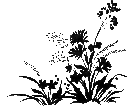 |
The Preserve |
News and Events |
Natural History |
The Trail |
Monitoring |
Restoration |
Library |
Organization |
|
Todmorden Mills Wildflower Preserve
|
Nature NotesYour Nature Guide for the week of September 26-October 3WildflowersThe distinctive palette of fall wildflower colours, consisting of purples, yellows and whites is now in full swing. New England Asters, with their bright purple flowerheads and yellow centres, are continuing to bloom in profusion. In the woodland, Zig-zag Goldenrod is still attractive, although, in the meadows, Canada Goldenrod flowers are fading and the buff-coloured seed heads are taking on their characteristic woolly appearance. Two of the common white-flowered asters can be distinguished easily on the basis of leaf shape. The Heath Aster, which grows in dry, sunny sites such as the landfill area behind the parking lot, has small, almost spine-like leaves densely arranged on the stem. The Heart-leaved Aster, on the other hand, prefers the shady edges of the woodland. Its leaves are large and oval-shaped with a deep notch at the base, hence the name "heart-leaved". InsectsIn the meadows, the recent hot, dry weather has sustained the insect activity. Green Darner dragonflies are still patrolling the open areas, and Tree crickets and Dogday Cicadas continue to call. A fascinating mutualistic relationship between Treehoppers and European Fire Ants can still be observed on the underside of Jerusalem Artichoke and Goldenrod leaves. Treehoppers, clustered at the mid-veins, are attended by the ants who protect the bugs and stimulate them to feed and to excrete honeydew which the ants harvest. Fortunately, the ants are much less aggressive than earlier in the summer, and close inspection of the colonies is possible. Trees, Shrubs and VinesThe Todmorden Mills Wildflower Preserve is a highly modified site, but it still has some large specimen trees. Immediately behind historic Helliwell House are two fine native Black Walnut trees. Last year at this time the slope was littered with the bright green fruits, and Grey Squirrels were busy dehusking them and carrying off the nuts. This year, neither tree has produced fruits--this irregular seed production is normal, and any given tree will produce a heavy crop of nuts about twice in five years. It is thanks to these trees and the Grey Squirrels that the Preserve is being re-populated with Black Walnut. A few trees have been planted, but most of the small Black Walnut trees in the Preserve, some close to the trail, have germinated from nuts cached by squirrels in the fall but which were never recovered and eaten. Virginia Creeper is now bright red and most distinctive. Resident and migratory songbirds, such as Catbirds, Robins and Blue Jays, are plucking the ripe fruit from the vines. Most Staghorn Sumac shrubs also have bright red leaves. The dark red fruits are ripe but are less attractive to birds and they will remain on the shrubs well into winter. BirdsThe migration of birds-of-prey is well under way, judged by reports from High Park where there is an organized watch each fall. The Don Valley provides a natural flyway for migrants, and many birds likely travel high overhead Todmorden Mills as they wing south. Binoculars are helpful to pick migrants out in the sky, such as Hawks, Blue Jays and the occasional Eagle. Nature Notes is researched and written by Mike Dennison and Alejandro Lynch, and is published each week by Hopscotch Interactive (www.hopscotch.ca). In addition to this online version, Nature Notes is available as a print-friendly PDF and as a text-only email version. Please contact Mike Dennison to receive these, or for more info (tel: 416-696-7230, email: dennison@hopscotch.ca). |
| Copyright © 2003-2004 Todmorden Mills Wildflower Preserve |